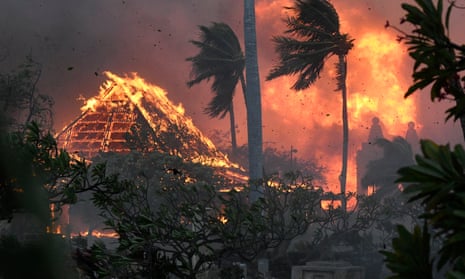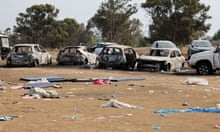All over Maui, golf courses glisten emerald green, hotels manage to fill their pools and corporations stockpile water to sell to luxury estates. And yet, when it came time to fight the fires, some hoses ran dry. Why?
The reason is the long-running battle over west Maui’s most precious natural resource: water. That’s why, on Tuesday 8 August, when Tereariʻi Chandler-ʻĪao was fleeing the fires in Lahaina, she grabbed a bag of clothes, some food – and something a little unconventional: a box filled with water use permit applications.
Despite her personal calamity, Tereariʻi, a grassroots attorney, already knew that the fight for Maui’s future was about to intensify, and at its heart would not be fire, but another element entirely: water. Specifically, the water rights of Native Hawaiians, rights that a long parade of plantations, real estate developers, and luxury resorts have been stifling for nearly two centuries. As the flames approached, Tereariʻi feared that, under cover of emergency, those large players might finally get their chance to grab west Maui’s water for good.
She also knew something else: that the only force with a hope of stopping that theft would be organized grassroots communities – even though those very communities were already stretched to breaking point saving lives and searching for lost loved ones.
Disaster capitalism – the well-worn tactic of exploiting moments of extreme collective trauma to rapidly push through unpopular laws that benefit a small elite – relies on this cruel dynamic. As Lee Cataluna, an Indigenous Maui-born journalist, observed recently, the people on the frontlines of disaster are necessarily focused on “survival stuff. Announcements. Services. Instructions. Help. Go here to get gas. Look at this list to see if your husband’s name is there” – not on coercive real estate deals or backroom policy moves. Which is exactly why the tactic too often succeeds.
Disaster capitalism has taken many forms in different contexts. In New Orleans after Hurricane Katrina in 2005, there was an immediate move to replace public schools with charter schools, and to bulldoze public housing projects to make way for gentrifying townhouses. In Puerto Rico after Hurricane Maria in 2017, the public schools were once again under siege, and there was a push to privatize the electricity grid before the storm had made landfall. In Thailand and Sri Lanka after the 2004 tsunami, valuable beachfront land, previously stewarded by small-scale fishers and farmers, was seized by real estate developers while their rightful occupants were stuck in evacuation camps.
It’s always a little different, which is why some Native Hawaiians have taken to calling their unique version by a slightly different term: plantation disaster capitalism. It’s a name that speaks to contemporary forms of neocolonialism and climate profiteering, like the real estate agents who have been cold-calling Lahaina residents who have lost everything to the fire and prodding them to sell their ancestral lands rather than wait for compensation. But it also places these moves inside the long and ongoing history of settler colonial resource theft and trickery, making clear that while disaster capitalism might have some modern disguises, it’s a very old tactic. A tactic that Native Hawaiians have a great deal of experience resisting.
Which brings us back to what was in that box that Tereariʻi rescued, and the place of water in this fateful moment. For over a century, water across Maui Komohana, the western region of the island, has been extracted to benefit outside interests: first large sugar plantations and, more recently, their corporate successors. The companies – including West Maui Land Co (WML) and its subsidiaries, as well as Kaanapali Land Management and Maui Land & Pineapple Inc – have devoured the island’s natural resources to develop McMansions, colonial-style subdivisions, luxury resorts and golf courses where cane and pineapple once grew.
This historical and modern plantation economy has taken a tremendous toll on water in particular, draining Indigenous ecologies of their natural moisture. Lahaina, once known as the Venice of the Pacific, has been transformed into a parched desert, which is part of what has made it so vulnerable to fire. Plantation skimming wells dried up Mokuhinia, an at least 15-acre freshwater fishpond, that nourished Mokuʻula, an island within the pond that was the seat of the Hawaiian Kingdom. In the early 1900s, the plantation filled Mokuhinia with dirt, and eventually a baseball field and parking lot appeared over the sacred site.
Even long after most of those original plantations closed, the infrastructure and dynamics of water theft remained. Today, many Native Hawaiian communities, who have lived in Maui Komohana since time immemorial, remain cut off from water for their basic needs, including drinking, laundry and traditional crop irrigation. For instance, Lauren Palakiko, whose family has resided in Kauaʻula for centuries and has priority water rights under the law, last year testified at a state water commission hearing that she had to bathe her baby in a bucket because not enough water reached her home. That’s because the streams that once flowed through their valley are diverted for luxury subdivisions, which often occupy plantation-controlled lands.

It’s a situation that has left many Native families with no access to county water lines (which also means no fire hydrants) as well as no paved roads to escape the fires that increasingly threaten their homes and lives. For example, the Native Hawaiian families of Kauaʻula valley, which flanks Lahaina, are beholden to Launiupoko Irrigation Co (LIC), a subsidiary of WML, because LIC owns the valley’s plantation-era water system. It takes nearly all of Kauaʻula Stream to service affluent estates in a neighboring valley and shuts off water completely to the Kauaʻula families’ homes when it alleges that there is not enough water to both sell to its customers and comply with the water commission’s stream protection standard.
The climate emergency has only deepened these tensions, worsening droughts and, as the world now knows, creating conditions ripe for wildfires. Over the last five years, fires have ravaged Kauaʻula valley, intensifying the wars over who has the right to access scarce water, including for critical firefighting uses.
In this high-stakes context, growing numbers of Native Hawaiian communities have organized to assert their water rights, which are supposed to have the highest protection under Hawaii law, including its constitution, statutory water code, and landmark Hawaii supreme court precedents. Native Hawaiians across Maui Komohana have partnered with lawyers for nearly three decades in pursuit of restorative justice, most recently with pro bono attorneys, like Tereariʻi, and students at Ka Huli Ao Center for Excellence in Native Hawaiian Law at the University of Hawaii’s Richardson School of Law.
Together, the communities have been fighting for their right to manage their own water rather than watch as it is diverted for often frivolous uses. June 2022 saw a historic victory: heeding the overwhelming demands of Native Hawaiians and other residents, the water commission voted unanimously to designate west Maui as a surface and groundwater management area. Under Hawaii’s water code, this designation invokes the commission’s permitting authority to protect priority Native Hawaiian rights and the environment over the historical and ongoing overexploitation of water by plantations and developers.
After protracted struggle, and despite predictable opposition from industry, the community and the water commission prevailed, instituting a new permitting system that the community hoped would restore public control over water that had been stolen for over a century. The Palakiko family and others began filling out water use permit applications requesting water for their household needs, like bathing their babies, and also water for Indigenous wetland agriculture.
But here’s the cruelest irony: the deadline to submit those permit applications to the water commission was on Monday 7 August. And the fire that devoured Lahaina was the very next day.
The Hawaii governor’s administration wasted no time in issuing emergency proclamations that suspended a series of laws, including Hawaii’s “state water code, to the extent necessary to respond to the emergency”. The plantation successors leapt into action, attempting an end run around the designation process that they had been unsuccessful in stopping before the emergency proclamation. In the days after the fires, WML demanded the water commission suspend protections for streams across Maui Komohana – even in areas untouched by fire – and insinuated that the commission’s deputy director, Kaleo Manuel, who had been the agency’s public face throughout the designation process, was to blame for the destructive fire. The commission chair granted the request, allowing the corporation to divert the streams to fill the reservoirs that service its luxury developments. WML finally requested that the entire designation process “be suspended and ultimately modified”. Its own executive publicly stated: “I would love to see it gone” – a move denounced by the Earthjustice managing attorney Isaac Moriwake as an attempt to “use this tragedy for cheap advantage”.
Then, on Wednesday, with searches for survivors still very much under way, the administration announced it was “re-deploying” Manuel, effectively relieving him of all duties and banishing him to an unknown different post. The move has left the commission without an administrative leader.
This is a classic case of the most craven disaster capitalism: a small elite group using a profound human tragedy as their window to roll back a hard-won grassroots victory for water rights, while removing civil servants who pose a political inconvenience to the administration’s pro-developer agenda.

Hawaii’s governor, Josh Green, meanwhile, has parroted WML’s accusations, blaming “water management” as a primary culprit for there being insufficient water to fight the fires. In words that many saw as inflammatory, he seemed to imply that the fight for water justice was responsible. “It’s important we start being honest,” he said. “There are currently people still fighting in our state [about] giving us water access to fight and prepare for fires even as more storms arise.”
Many Maui Komohana communities refuse to accept WML’s rewriting of history. They know, for example, it was actually high winds that prevented helicopters from fighting the fires, and when they were ultimately used, seawater proved more accessible. They also understand that the desiccated conditions that made the region so vulnerable are a result of over a century of settler colonialism, in which Indigenous resources have been hoarded by the plantations and their successors. As Hawaii’s poet laureate, Brandy Nālani McDougall, explained, if “water was allowed to flow, where it was allowed to be created and continued to feed and nurture everyone it should, this wouldn’t have happened”.
If there is a cause for hope, it’s that Maui’s people have learned from their history. Yes, irreplaceable historical and cultural artifacts have been lost to the flames but not the teachings that those artifacts represent. Native Hawaiians know what their rights are – to stay on their ancestral lands, to restore streamflows to those lands, and to ensure their Indigenous lifeways will persevere in the face of a climate crisis fueled by colonial pillage. Indeed, those traditional lifeways historically restored abundance to the islands, while plantation mismanagement has turned the land into a desert. That’s why grassroots organizers like Tereariʻi knew to take that box of precious papers relating to water rights, filled with notes collected during careful community engagement and consultation.
This hard-won knowledge is also why, as soon as the real estate developers started circling, local residents began organizing to call out disaster profiteering. Many have also committed to securing the resources required to get families back into rebuilt homes – and to be the authors and architects of their own post-disaster reconstruction, a process grounded in aloha ʻāina, the ethos of deep reverence for natural and cultural resources.
That ethos is the reason that water is a public trust in Hawaii, not owned by anyone – not the governor, WML or even Native Hawaiians with ancestral ties to the resource. Instead, under Indigenous law, water is zealously stewarded for present and future generations so that all can thrive. While politically inconvenient for some, this principle is what will preserve life on these fragile islands. Aloha ʻāina enabled Native Hawaiians to flourish in Hawaii for a millennium, and it’s precisely this kind of biocultural knowledge that is needed to navigate the path forward in a time of climate crisis.
Hawaii is indeed in an emergency, but it needs emergency proclamations that operationalize aloha ʻāina, not ones that push it aside by opportunistically suspending inalienable water laws and dismissing diligent public servants. What this governor does next will determine if Maui Komohana will remain a space for Indigenous and other local families like the Palakikos, or if companies like WML and its affluent customers are empowered to complete their takeover of land and water in west Maui.
Right now, the eyes of the world are on Maui, but many don’t know where to look. Yes, look to the wreckage, the grieving families, the traumatized children, the incinerated artifacts, and donate what you can to community-led groups on the ground. But look below and beyond that too. To the aquifers and streams, and the plantation-era diversion ditches and reservoirs. Because that’s where the water is, and whoever controls the water controls the future of Maui.
The fee for this article is being donated to help rebuild the Maui Cultural Center, which is managed by Nā ʻĀikane o Maui. Also consider supporting Red Lightning, which is organizing relief and other support services on Maui right now.
Kapuaʻala Sproat is a Professor of Law at Ka Huli Ao Native Hawaiian Law Center & the Environmental Law Program. She also co-directs the Native Hawaiian Rights Clinic at the University of Hawaii at Mānoa’s William S Richardson School of Law









